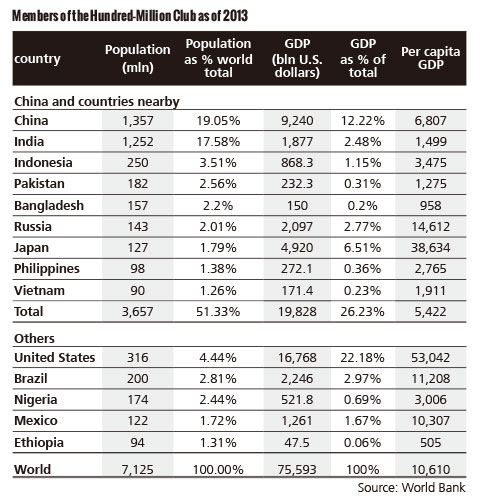When Eyeing Overseas Markets, China Should Target Hundred Million Club
The Silk Road initiatives are good ideas, but to deal with its huge oversupply China must do more business with countries with big populations
By Yu Xiaohua
RELATED POSTS
One of the gravest challenges China faces as its economic growth rate slows is oversupply of output in some industrial sectors. Because it is the second-largest economy in the world and has the biggest population, the scales alone mean it carries enormous weight in the global economic and trade system. Policymakers must take this into consideration when forming strategies, and to facilitate this, we propose the concept of the Hundred-Million Club.
China has a very severe problem of industrial oversupply. Table 1 shows its output in several major industries in 2013 and their shares in the global total.
 |
Absorbing this much overcapacity requires a huge international markets as domestic demand plateaus. To explore the markets overseas, the Chinese government has raised many economic strategies, including the Silk Road initiatives, which refer to the Silk Road Economic Belt and the 21st-Century Maritime Silk Road. Geopolitics is apparently a big factor behind the move. From a purely economic perspective, however, some countries may not have a big enough market.
The Silk Road Economic Belt includes mainly five Central Asian countries, namely Kazakhstan, Turkmenistan, Kyrgyzstan, Uzbekistan and Tajikistan. Data from the World Bank shows that these countries combined had a population of 66.45 million, or 4.9 percent of China's. The figure is roughly on par with that of an average-sized Chinese province. Also, in terms of gross domestic product in U.S. dollars, the five countries' combined GDP was about 3.7 percent of China's in 2013. Their per capita GDP that year was US$ 5,211, compared with China's US$ 6,807.
These are far from economies that are able to absorb China's overcapacity. China can certainly import resources such as oil and grain from the five, but when exports are concerned, all of them combined account for only a small market.
Of course, small economies cannot be neglected, but more attention should be focused on large economies and those with the potential of becoming one.
Population matters. It is a resource and it is market. China's foreign economic strategies must focus on countries with large populations.
Table 2 lays out 14 countries with populations of close to or more than 100 million people. This is what I call the Hundred-Million Club.
 |
In 2013, the population of the 14 countries accounted for 64 percent of the world total. Their combined GDP was 53.8 percent of the total. Excluding the United States and Japan, the other 12 countries' population accounted for 60 percent of the world's total, and yet their GDP was only one-quarter of the total. This means the 12 countries still have a long way to go in terms of economic development.
Among the 14 countries, eight are next to or near China. We call them and China the Eastern Hundred-Million Club. Their population comprised 51.3 percent of the world's total, but their economies were only 26.2 percent of total GDP. If Japan is not included, the other eight countries had half of the world's population and yet one-fifth of its GDP. The room for their growth is huge.
China's foreign economic strategy should focus on the members of the club. They are the countries that will provide us with a huge market, and special attention should be paid to the eight surrounding us, for geopolitics reasons.
Besides, it is also China's responsibility to drive the Eastern club's development, for its per capita GDP among the countries ranked behind only Japan and Russia.
The overcapacity China is grappling with now was to a large extent caused by its rapid growth in the past 30 years. On the flip side, other less developed yet populous countries may need it to kick-start their economies because they need infrastructure to develop industries. The Chinese government has realized this and led efforts to establish an Asian Infrastructure Investment Bank, whose mandate is to finance these countries' infrastructure construction.
Apart from Japan and Russia, China and its nearby countries in the club are all developing economies with dense populations and relatively few national resources. China should strengthen its communication and cooperation with these countries on economics, research and technologies, and international security. For example, it can run joint research projects in agriculture and set up a shared grain reserve system to cope with natural disasters.
It is, however, worth noting that the nine Eastern club members have very complex relationships and even come into conflict for historical and religious reasons. China is the largest economy among them. Its per capita income is not the highest, but still greater than that of many others. It has established a market economy and is competitive globally in some industries. It should open its markets to those countries, transfer some of its outdated industries to them and integrate with them more closely in economy.
Over time, the economic integration it leads will pay off. It will be able to reduce geopolitical conflicts in eastern and southern Asian areas and bring prosperity to the region.
Yu Xiaohua is a professor at the University of Göttingen's Courant Research Centre of Poverty, Equity and Growth in Developing and Transition Countries






No comments:
Post a Comment